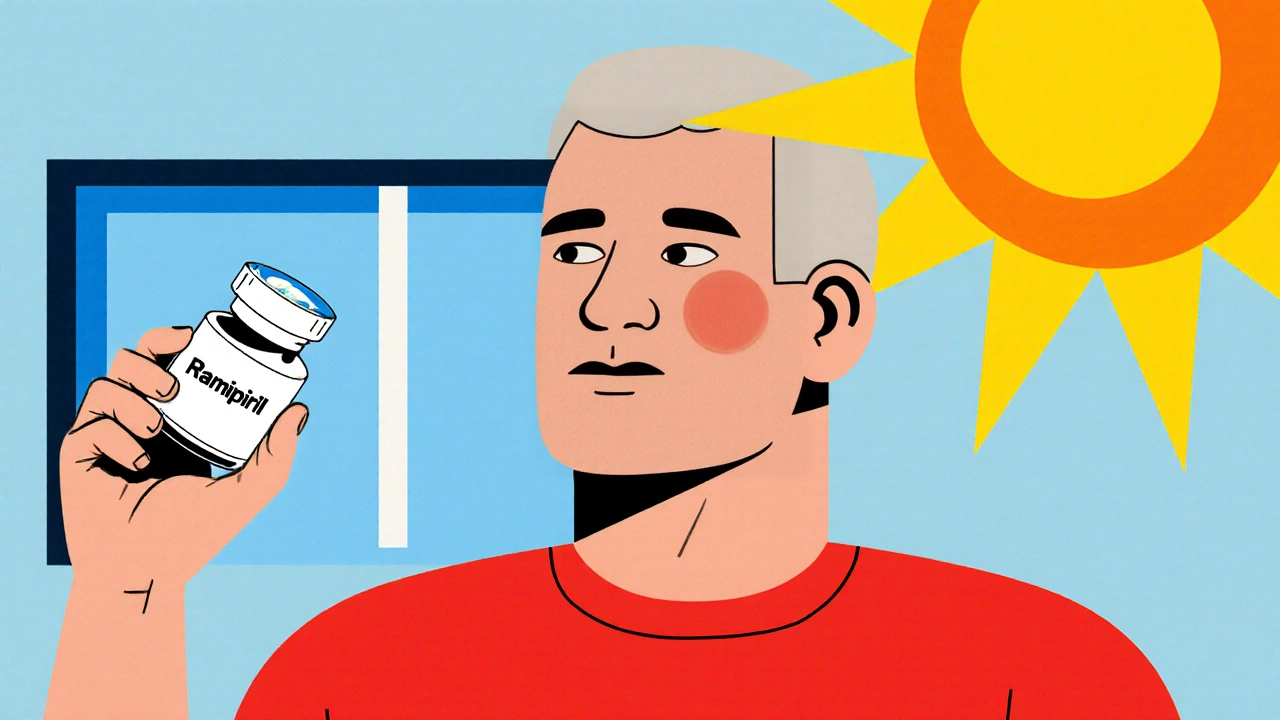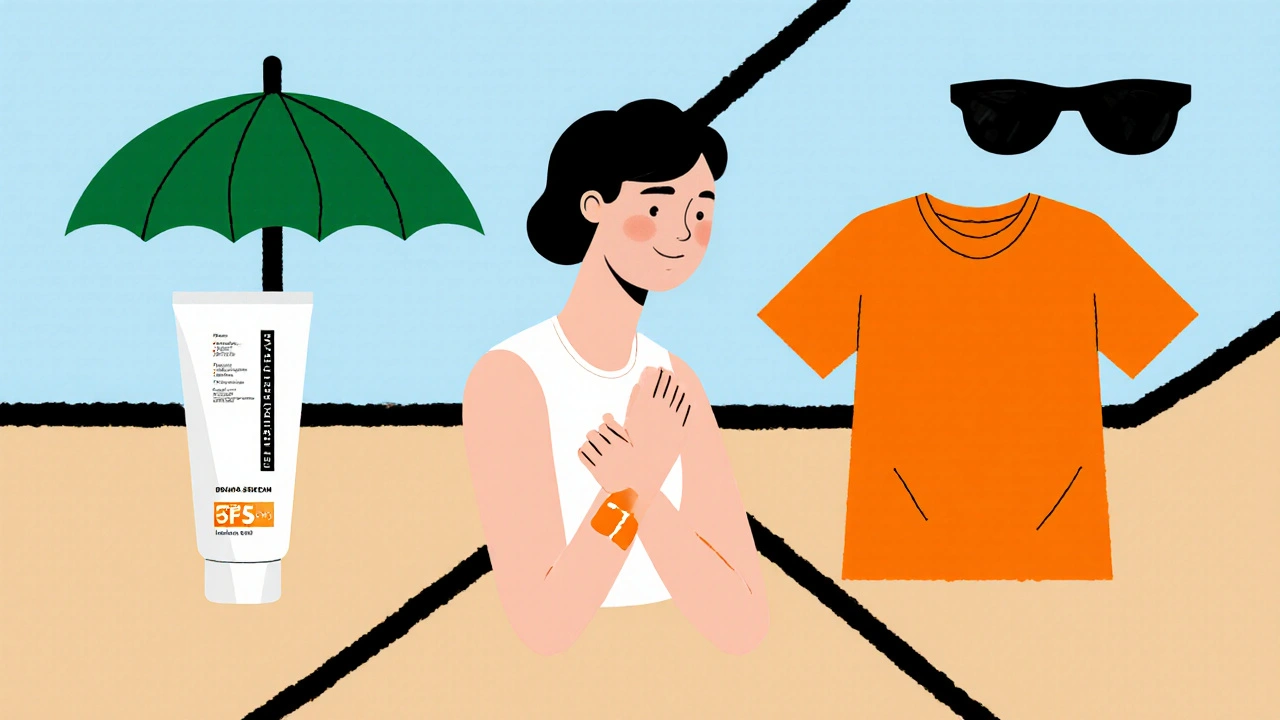Ramipril and Sun Sensitivity: How to Safeguard Your Skin
 Oct, 22 2025
Oct, 22 2025
Ramipril Sun Sensitivity Risk Calculator
Personal Risk Assessment
Answer a few questions to determine your sun sensitivity risk while taking Ramipril. Results show your personalized protection needs.
Your Personalized Risk Assessment
Recommended Protection
Ramipril is an ACE inhibitor prescribed to lower blood pressure and protect heart health. While it’s great for hypertension, many patients notice their skin reacting more sharply to sunlight. This article walks you through why that happens, who’s most at risk, and concrete steps to keep your skin safe.
Why Ramipril Can Increase Sun Sensitivity
Ramipril belongs to the ACE inhibitor class. These drugs block the conversion of angiotensin I to angiotensin II, which relaxes blood vessels and reduces blood pressure. A side effect that’s less talked about is a heightened reaction to UV radiation. The exact mechanism isn’t fully settled, but research suggests a few possibilities:
- Altered skin blood flow makes the epidermis more prone to damage.
- Changes in melanin production can lower the natural sunscreen effect of darker skin.
- In some patients, a phototoxic reaction occurs, where the drug absorbs UV light and creates reactive oxygen species that injure skin cells.
Even if you’ve never experienced a rash before, it’s wise to assume a modest increase in photosensitivity while on Ramipril.
Who Is Most Likely to Notice Sun Sensitivity?
Not everyone on Ramipril will see a skin change, but certain factors raise the odds:
- Skin type: Fair‑skinned individuals (low melanin levels) burn faster.
- Geography: Living at high altitude or near the equator means stronger UV exposure.
- Season: Summer months and sunny weekends increase cumulative dose.
- Concurrent medications: Some antibiotics, diuretics, or other heart drugs can compound photosensitivity.
If you fit one or more of these profiles, be extra diligent with protection.
Practical Steps to Protect Your Skin
Below is a quick‑reference checklist that works for anyone, but especially for those on Ramipril:
- Apply a broad‑spectrum sunscreen with at least SPF 30 every morning. Reapply every two hours, or after swimming or sweating.
- Choose a sunscreen labeled “UVA/UVB” or “broad‑spectrum” to block both short‑ and long‑wave radiation.
- Wear protective clothing: long‑sleeve shirts, pants, a wide‑brim hat, and UV‑blocking sunglasses.
- Seek shade between 10 am and 4 pm, when UV intensity peaks.
- Consider a physical (mineral) sunscreen containing zinc oxide or titanium dioxide; these tend to be less irritating for sensitive skin.
For those who spend a lot of time outdoors-gardeners, bikers, athletes-adding a UV‑protective shirt and a lip balm with SPF can make a big difference.

When to Seek Professional Advice
If you notice any of the following, schedule a visit with your dermatologist or primary care physician:
- Unexplained red patches that worsen after sun exposure.
- Itchy or burning sensations that linger for days.
- Blistering or peeling skin that looks like a severe sunburn.
Sometimes the doctor may adjust your dose, switch to a different hypertension medication, or suggest a short course of topical steroids to calm inflammation.
Comparing Sun‑Protection Strategies
| Method | Effectiveness (SPF Equivalent) | Pros | Cons |
|---|---|---|---|
| Broad‑spectrum sunscreen (SPF 30‑50) | 30‑50 | Easy to apply, re‑usable | Needs frequent re‑application |
| Physical sunscreen (zinc oxide) | ~30 | Less irritation, broad coverage | Can feel thicker on skin |
| Protective clothing (UPF 50+) | 50+ | Long‑lasting, no re‑apply needed | May be hot in summer |
| Shade & timing avoidance | Varies | Free, reduces overall UV load | Limits outdoor activities |
Mixing methods gives the best defense-think of sunscreen as your first line, clothing as the shield, and shade as the fallback.

Key Takeaways
- Ramipril can make skin more reactive to UV light, especially in fair‑skinned or outdoor‑active people.
- Broad‑spectrum sunscreen with SPF 30 + protective clothing are essential daily tools.
- Watch for persistent redness, itching, or blistering and consult a healthcare professional promptly.
- Adjusting lifestyle habits (shade, timing) can dramatically lower risk without compromising medication benefits.
Frequently Asked Questions
Does every ACE inhibitor cause sun sensitivity?
Not all ACE inhibitors have the same photosensitivity profile. Ramipril and lisinopril report higher rates, while others like enalapril are less commonly linked. Still, any new skin reaction warrants a doctor's look.
Can I skip sunscreen if I stay indoors most of the day?
Windows block most UVB but allow UVA, which still contributes to photosensitivity. If you sit near a sunny window for long periods, a light SPF moisturizer is a good safety net.
Is a higher SPF always better?
Higher SPF offers diminishing returns after about SPF 50 and can feel greasier. For most people, SPF 30‑50 applied correctly provides sufficient protection, especially when paired with clothing.
Should I stop Ramipril if I develop a rash?
Never stop a prescription on your own. Contact your prescriber; they may switch you to another antihypertensive that doesn’t affect skin sensitivity.
Are there natural alternatives to sunscreen?
Foods rich in antioxidants (like berries or green tea) support skin health, but they don’t replace sunscreen. Physical barriers-clothing, hats, sunglasses-remain the most reliable non‑chemical options.

Emily Collins
October 22, 2025 AT 18:29When my doctor first put me on Ramipril I felt like I’d finally tamed the wild beast of high blood pressure, but the sun had other plans for me. The first summer after starting the pill, I stepped out for a quick jog and felt an odd sting on my forearms as if the air itself were scorching. By the time I returned home, a reddish rash blossomed across my cheeks, as though a phoenix had tried to rise from my skin. I laughed it off at first, thinking maybe I’d just overcooked a burger, but the next day the same pattern reappeared after a short walk in the park. It wasn’t just a fleeting flare; the irritation lingered, itching like sandpaper and turning my skin sensitive to every stray beam of light. I read the medication leaflet and discovered that Ramipril can indeed heighten photosensitivity, a fact my pharmacist barely mentioned. Determined not to let this ruin my outdoor hobbies, I turned the situation into a mission to master skin protection. I bought a broad‑spectrum SPF 50 sunscreen and made a ritual of slathering it on like armor before each sunrise. I also invested in a UPF 50+ shirt, a wide‑brimmed hat that shaded my face, and polarized sunglasses that felt like a visor from a sci‑fi movie. The difference was night‑and‑day; the rash stopped appearing, and the burning sensation faded into a faint memory. I even started timing my walks to avoid the 10 am to 4 pm UV peak, favoring early mornings when the world was still soft. My friends teased me for my “sun‑shield” gear, but I wore it proudly, knowing my heart health and skin could coexist peacefully. I also keep a small travel‑size sunscreen in my bag, so accidental sun exposure never catches me off guard. If you’re on Ramipril and notice any unusual redness, don’t ignore it – schedule a visit with your dermatologist before the problem escalates. Remember, the same drug that protects your heart can make your skin a bit more vulnerable, but with the right armor you can enjoy the sunshine safely.
Rachael Turner
October 27, 2025 AT 08:35Sunlight has always been a paradox of life it gives us warmth yet can also betray us when our bodies shift the balance. On medications like Ramipril the skin becomes a more delicate canvas, absorbing the invisible fire of UV with less resistance. One could say that the drug nudges us to reconsider how we share space with the world, to dress the body in intention. A simple habit like applying sunscreen becomes an act of mindfulness, a quiet reminder of our fragility. In that quiet moment we find a deeper respect for the cycles of day and night.
Vin Alls
October 31, 2025 AT 23:42Great call on the SPF armor, Vin here with a few extra nuggets. First off, pair that sunscreen with a zinc‑oxide base if you’ve got sensitive skin – it forms a literal shield that reflects UV like a mirror. Second, remember to reapply every two hours or after any sweat session; the active ingredients can wash off like tide on a sandcastle. Third, consider a lip balm with at least SPF 15; chapped lips are a silent cry for protection. Finally, keep an eye on any other meds you’re juggling – diuretics and certain antibiotics can amplify the photosensitivity cocktail. Think of your regimen as a symphony; every instrument needs to be in tune for the melody of safe sun exposure.
Tiffany Davis
November 5, 2025 AT 14:49I agree with the practical steps mentioned earlier – a solid sunscreen routine, protective clothing, and shade during peak hours are the basics that work for most people. Keeping a consistent schedule helps make these habits feel like part of your daily routine rather than an extra chore.
Diane Thurman
November 10, 2025 AT 05:55Honestly the advice above is kinda overblown – you dont need that many fancy steps. Just slapp a cheap SPF 30 on and youre fine. If you’re obsessing over zinc‑oxide like its some magic potion you’re missing the point – sunscreen works. Stop reading too much into every detail and just do the basics.
Iris Joy
November 14, 2025 AT 21:02Remember, protecting your skin isn’t just about avoiding burns – it’s also about long‑term health. Think of each application of sunscreen as a small investment in your future, and don’t be afraid to ask your pharmacist for recommendations that suit your specific skin type. You’ve got this, and with a few simple tweaks you can stay safe while still enjoying the outdoors.
Tammy Sinz
November 19, 2025 AT 12:09To build on Iris’s point, it’s essential to incorporate photoprotection into the overall therapeutic regimen. Consider the photobiological impact of Ramipril as part of the drug‑skin interaction matrix; the reactive oxygen species generated can be mitigated by topicals containing antioxidant complexes such as niacinamide or ferulic acid. Moreover, dosing schedules that align with circadian rhythms can reduce peak plasma levels during high‑UV periods, further lowering dermal risk. Integrating these strategies creates a multifaceted barrier against phototoxicity.
Sajeev Menon
November 24, 2025 AT 03:15Hey folks, just wanted to chime in – wearing UPF shirts is a game changer, especially when you’re out for long hours. I found a lightweight one that didn’t make me feel like I was in a sauna. Also, keep a small travel‑size sunscreen in your bag, so you’re always prepared. Small steps add up to big protection.
Wade Grindle
November 28, 2025 AT 18:22Great tip, the travel sunscreen saved me last weekend.
Benedict Posadas
December 3, 2025 AT 09:29Yo everyone! 🙌 Don’t forget to slap on some SPF before you hit the trail – even on cloudy days the UV still sneaks in! If you’re on Ramipril, think of sunscreen like a superhero cape, it’s gotta be on! Plus, grab a hat that covers your ears, you’ll thank yourself later 😎.
Jai Reed
December 8, 2025 AT 00:35While enthusiasm is commendable, it is imperative to emphasize that proper sun protection is non‑negotiable for patients on Ramipril. Failure to adhere to these measures can lead to preventable dermatologic complications, and such negligence is unacceptable.